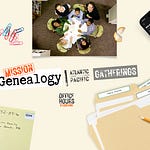This recording captures my presentation from today’s Office Hours program.
Organizing Your Substack
As I shared in the preview post earlier this week, the topic of techniques to organize your substack requires that we cover several related elements. This talk builds on concepts discussed in our October and November programs. This time, I decided to start with two related aspects, Tags and Sections, then defer a discussion of the Edit Theme function until January.
Tags & Sections
Substack presents Tags and Sections as entirely separate concepts, but I think it’s helpful to understand them together. The key is to realize that:
Tags are like labels. One post can have as many Tags as you’d like.
There are strategies to using Tags effectively, but that’s a topic for a separate conversation.
Sections are like places, and the default is your entire substack. Any article can appear in just one section.
Sections allow you to collect related articles on a topic.
When you have multiple sections, your subscribers can subscribe to some sections, not others.
Here are relevant documentation pieces from Substack:
Two related topics missed in the presentation that we covered in some detail in the discussion included:
1. Newsletters & Sections
Substack refers to each section as a distinct newsletter. If you’ve not added separate sections, the entire substack is one newsletter.
When Subscribers subscribe to a publication, the owner decides which newsletter they’re subscribed to. The default is to add new subscribers to all newsletters automatically. We do this at both Mission: Genealogy and the
. You can modify this for each Section in your Publication Dashboard.To see if any particular Substack includes multiple newsletters, visit that Substack at xxx.Substack.com/newsletters. From there, you can opt-in and out of different newsletters offered (unless they’re paywalled.)
See MissionGenealogy.Substack.com/newsletters, for example, with a few sections, or Projectkin.Substack.com/newsletters, where I have a baker’s dozen. In both cases, we use sections for each event type we host.
2. Cross-posting, Tags & Sections
We briefly discussed cross-posting during the program. Cross-posts allow you to share another Substacker’s post with your subscribers on your site and optionally via email. You can add a comment to contextualize the post for your readers in a preface.
When you share someone else’s post on your Substack, you cannot access configuration details like tags and sections. That means their article will appear on your site wherever a “latest post” appears. We’ll cover where these appear when we talk about Edit Theme in January.
Note: If you want to control how someone else’s Substack post appears on your Substack, you can also “embed” their post in a post of your own. I used this approach with Projectkin when my guest speaker of ran a post about her new “Forget-me-Not” series for Projectkin. I wanted to cross-post her post, but in doing so, I would lose control. Instead, I wrote a post of my own and embedded hers so it could appear in the section, /forget-me-not. Here’s that post embedded in this post on a different Substack. (See how powerful this can be with collaborations?)
Here are a couple more related Substack articles:
“How can I share another publication's post with my subscribers?”
“How do I share posts or publications from other writers on my Substack?”
Tags, Sections, and Organizing Your Substack
We’re taking the time to go through Tags and Sections now because they’re foundational as a tool for organizing your Substack. Each Tag and Section generates a unique link you can reference in the navigation bar for your Substack. See the discussion in the slides:
Gatherings
We’ll cover the Substack Organization topic in next month’s “Gatherings” (sessions that, starting in 2025, will combine Roundtables and Office Hours programs. See what I did there 👀 with links to sections?).
We’ll host the first Gathering on January 7th and 14th (then the first and second Tuesday of each month in the Atlantic region or the Wednesday in the Pacific.) These combined 90-minute sessions timed for the Atlantic and Pacific Regions. All events are free, and everyone is welcome (regardless of their home region.)
Explore the MissionGenealogy calendar at the link below 👇

Discussion
As with all of these programs, our discussion during today's event was wide-ranging. We don’t record these to ensure that everyone feels comfortable asking questions. Sometimes, it can be hard to ask a question that feels a little stupid if you know the whole thing will be recorded. Your questions are always welcome here. Have more for us? Drop them into the comments below 👇.
Remember, is a free, voluntary community, you can help us help each other by sharing our work and those of other community members.
By using the buttons below or the Share button above, you can Restack this post as a Note to share with your followers. Using the Share button, you can share it as a link with your friends and followers on social media or in email. Our mantra: “A rising tide lifts all boats.”


















Share this post